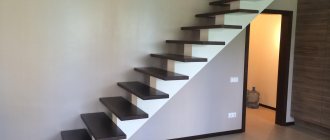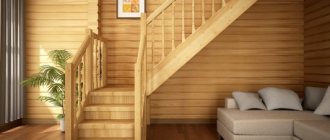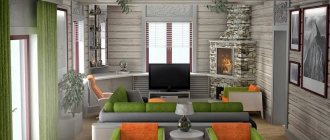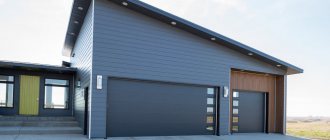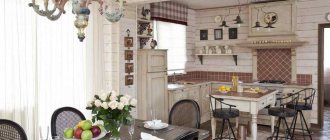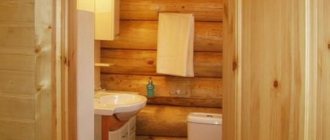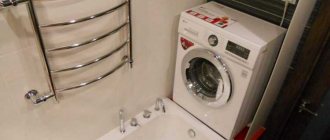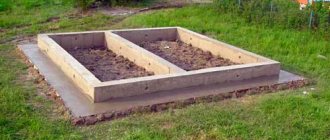The necessary conditions
Installing a toilet under the stairs is an excellent idea. However, in order to implement it, it is necessary that the room under the stairs meet several requirements:
- Availability of the technical ability to install a water supply and sewerage system.
- Location of forced ventilation equipment.
- Possibility of waterproofing.
- The minimum area for a toilet under the stairs is 80x120 cm. If you want to install not only a toilet there, but also a sink, bathtub, and washing machine, then this area should be much larger.
- At the point where the toilet is planned to be installed, the distance from the ceiling to the floor must be at least 1 m.
- The height of the room at the entrance to the bathroom under the stairs should exceed the height of the tallest family member.
- The door of such a bathroom will swing outward. It is often not possible to install a swing door in the toilet under the stairs. In this case, you can successfully use a sliding or folding structure. However, their disadvantage will be that they cannot protect against odor well and have a low level of noise insulation.
Premises requirements
The toilet under the stairs is landscaped taking into account a number of requirements. Among them:
- it is necessary to provide sewerage and water;
- a ventilation system must be organized;
- all joints are waterproofed;
- the size of this room must be at least 0.8x1.2 m;
- the distance from the ceiling to the toilet is at least 1 m;
- The door should open to the outside.
In addition, when determining the height of the ceiling, the height of the tallest family member should be taken into account. After all, each member of the household needs to feel as comfortable as possible in this room.
Design
The choice of style for decorating a bathroom depends on personal preferences. Let's look at the most popular destinations.
- Minimalism. A room in this style will look stylish and laconic. The style is characterized by the use of one or two contrasting colors, and natural textures are also often used. Minimalism is perfect for a small bathroom, since the direction does not require bulky furniture and numerous decorative elements. Such interiors are often decorated with lighting.
- Classical. Such a bathroom will look expensive and elegant. It is characterized by the use of wallpaper or tiles with unusual patterns, as well as gold or bronze fittings of intricate shapes. The interior can be decorated with paintings, vases and other elements.
- Provence. A room in this style always looks gentle and romantic. Pastel colors will visually expand the space and make it lighter. When decorating, it is important to choose beautiful accessories and original textiles. In the Provence style, mosaics and decorative tiles with unusual patterns are often used.
- Ecostyle . This is a fairly new direction, for the design of which natural wood and stone are often used. The interior can be complemented with glass or stone decorations.
A wall panel depicting plants will look stylish and unusual.
- Loft. This is another beautiful solution for a small space. Loft does not require the use of a large number of accessories. A stylish design is created using wood and stone textures or imitation brickwork.
Interior decoration
Interior design option for the bathroom
Due to the fact that the bathtub under the stairs has a small area, one of the main tasks when decorating the interior is to visually expand the space. Light colors will help to visually enlarge the room. Therefore, when choosing the color scheme of finishing materials, preference should be given to light shades. It can be white and the lightest shades of pink, yellow, olive or blue. Mirrors and glossy surfaces have the ability to visually expand space. By reflecting light, they make the room appear larger.
In addition to a regular mirror, you can hang cabinets with mirrored doors in the bathroom. Corner mirrors provide a significant effect of visually increasing space. Another option for decorating a small bathroom is to install a large mirror on the entire wall.
Important! When decorating a bathroom, you should remember that in a small room it is recommended to use small tiles and lay them diagonally. Using tiles of different shades, you can divide a small room into zones, thereby visually enlarging it. The effect of increasing space can also be achieved by using beautiful mosaics or tiles with an unusual texture (like wood, brick or natural stone) on one of the walls.
You can visually enlarge a room with the help of properly installed lighting. To do this, it is recommended to use several point light sources located around the perimeter.
Finishing stage
First of all, when arranging a bathroom in the space under the stairs, the floor is waterproofed. If the walls are made of wood, be sure to treat them with products that protect against mold and rot.
Waterproofing material is selected depending on the type of floor covering:
- For natural wood, varnish or water-repellent impregnation is used.
- If the base is made of concrete, then polymer-bitumen mastic is first used, and after that a screed is made, on which tiles or a linoleum coating are laid.
- If you want to cover the bathroom floor with laminate, you can use bitumen-based insulating materials in rolls.
The finishing of the toilet under the stairs is usually carried out in the usual ways for bathrooms: laying tiles, gluing plastic panels or painting the walls with special moisture-resistant compounds.
It is better to make partitions from moisture-resistant plasterboard. You can easily putty it and paint it, and also stick tiles on it.
When planning a toilet under the stairs, be sure to consider the lighting system. Most design solutions usually use flat-shaped wall or ceiling lamps.
Bathroom
A large bathtub most likely will not fit under the stairs; installing a shower stall would be more practical. To do this, you need to take into account high humidity and constant temperature changes.
In finishing it is better to use moisture-resistant materials with good thermal insulation. Ventilation is required in the room.
Bathroom under the stairs
In country houses, the staircase has about 10 steps, which is quite enough for a toilet and a convenient washbasin. If your home is often full of guests, an extra bathroom will come in handy.
Instructions on how to arrange the space under the stairs:
Enclose the area with walls. The following sizes are recommended for the toilet:
- height from 1 m to 2.6 m;
- wall length is about 2.3 m;
- width from 1.2 m.
It is better to install the toilet itself in a smaller part of the room. Finishing at the request of the owners, for example, tiles on the floor, wooden walls.
What are the requirements for a bathroom under the stairs?
To make such a desire come true, you will need not only time and financial investments, but also the availability of suitable conditions. You need to take into account the specifics of the bathroom, as well as the materials from which the house as a whole and the staircase in particular are made.
Under the long flight of stairs there is enough space to install a toilet and washbasin
Read more about what needs to be considered when planning a toilet under the stairs in a wooden house:
- Possibility of equipping the selected space with all communications, namely water supply and sewerage.
- The need for forced ventilation.
Providing ventilation for the toilet will be quite simple if the staircase runs along the outer wall of the house. When placing the stairs inside the house, you will have to think about laying communications under the ceiling or through the second floor.
And these are not all the important parameters. The selected space must correspond to certain dimensions. The bathroom under the stairs must meet the following parameters:
- if you plan to install only a toilet, then an area of 0.8 * 1.2 meters will be enough (if the plans include placing a sink, bathtub or washing machine, then a larger area is needed);
The height of the room under the stairs should be comfortable, the ideal option is slightly higher than human height
The outer cladding of the door leaf can merge with the finishing of the stairs
If the space does not allow you to install a door that opens outward, you can choose sliding and folding options. However, they have a significant drawback: such structures do not provide sound insulation and odor protection.
If the selected room does not even meet the minimum recommended dimensions, then modern compact models of plumbing fixtures will be the way out.
Installation of a bathroom under the stairs
Construction of a toilet in the space under the stairs requires the presence of certain knowledge and skills.
This is a rather critical area, and the following aspects should be taken into account when designing:
- Carefully calculate whether the size of the niche allows you to place a bathroom underneath it.
- Possibility of connecting sewerage and water supply, installation of ventilation.
- When placing a toilet, be sure to treat the inside walls with antibacterial agents and waterproof the floor.
- Seasonal deformations are possible in a wooden house. This must be taken into account when laying communications (special damping devices are installed or gaps are provided), as well as when choosing materials for finishing.
The placement of a bathroom in residential buildings is regulated by building codes (SNiP). Despite the fact that strict rules do not apply to private houses, and it is permissible to arrange a toilet under the stairs in a wooden house in accordance with the existing conditions, based on ease of use, you should have an idea about these requirements.
The minimum toilet size is 0.8x1.2 m; with an installed sink - 1.6x2.2 m; combined with a bathroom - 2.2x2.2 m. Ceiling height - 2.5 m. There must be at least 0.6 m of free space in front of the toilet. The entrance to the bathroom is prohibited from the living room or kitchen. The door must only open outwards.
Let's take a step-by-step look at how to arrange a bathroom in a wooden house under the stairs with your own hands.
Improvement of a bathroom under the stairs: features and recommendations of specialists
Owners of private houses and cottages have the opportunity to choose a place to improve their bathroom and toilet. For example, a bathroom under the stairs would be an excellent solution. In this case, you just need to find out in advance what requirements are imposed on this room, and what will be needed during the main work. Only with a responsible approach to business will it be possible to create a successful design.
Communications
It is impossible to create a toilet without communications. At the stage of creating a project, it is necessary to think through everything carefully so that later difficulties do not arise.
The drain pipe can be connected directly to the septic tank or connected to a public sewer. It is important to maintain the optimal slope of the pipe to ensure good drainage of the contents. For a pipe with a diameter of 5 cm, it is recommended to create a slope in the range of 25-35 mm per 1 linear meter. For a diameter of 10 cm, it is necessary to maintain an angle of 12-20 mm per 1 linear meter.
The water supply can be extended from the general house water supply system using similar pipes.
If this is not possible, as is often the case in wooden houses, then you can supply water from a well or borehole using a pumping station.
If you want to create a bathroom for use in winter, then you need to choose the optimal depth for the water supply so that the ground does not freeze . Another solution would be to insulate the pipes with a heating cable.
If this is a summer house where there is no need to use water supply in winter, then before the onset of frost you should drain the water from the pipes.
The next important point will be the creation of a ventilation system. The duct must be pulled under the ceiling and led to an outlet in the wall or through the roof.
A ventilation system is necessary because without it the room will be too humid, which will contribute to the development of fungus and mold.
Installation of water supply and sewerage
To supply water to the bathroom and remove waste water, it is recommended to use pipes made of plastic and metal-plastic to eliminate possible deformations. Most often, PVC pipes with fittings are used for sewer installation.
Special rubber sealing rings are installed at their connection points. Pipes must be insulated using mineral wool or expanded polystyrene.
Sewage installation
PVC pipes and fittings
An important task when carrying out sewer installations is to ensure the free passage of drains, without delays or blockages.
To do this, it is necessary to provide for the angle of inclination of the pipes. It depends on the diameter of the pipes, and should ensure a liquid flow speed of 0.7-1 m/s (calculated optimal speed of sewer water).
The angle of inclination is determined in centimeters per 1 meter of pipe. The most convenient way is to set it using a level.
| Pipe D, mm | Tilt angle |
| 50 | 0,025-0,035 |
| 100 (110) | 0,012-0,02 |
| 150 (160) | 0,007-0,01 |
| 200 | 0,005-0,008 |
Requirements for sewerage are established in SP 30.13330.2012 “Updated edition of SNiP 2.04.01-85 “Internal water supply and sewerage of buildings”” and SNiP 2.04.03-85 “Sewerage. External networks and structures."
Typically, pipes with a diameter of 50 mm are used inside the house, and for external installation - 100-150 mm. To drain wastewater, a septic tank with a filter system is installed, in which the wastewater is purified in such a way that disinfected water can be safely discharged into the ground.
Septic tank for a country house
If it is not possible to install a competent septic tank, you can take a simpler route - dig a couple of concrete rings into the ground to collect sewage water, but then a problem with a fetid, pungent odor may arise.
Primitive waste storage tank
This scourge can be almost completely overcome by timely pumping out of the storage tank using special equipment and the use of enzyme preparations.
Sewage pumps are used to pump out sewage water. They differ in power, configuration (can be equipped with automatic equipment, a shredder), material of manufacture (steel, plastic, cast iron) and installation options (submersible, semi-submersible, surface).
Fecal pump
When choosing a pump, take into account:
- Transportation distance.
- Performance.
- Inclusion size.
- Chemical composition of wastewater.
- Temperature regime.
Installation of water supply
If there is no centralized water supply in the premises, the water supply is carried out from a well or borehole.
Laying a water supply system consists of several stages:
- Drawing up a detailed diagram of the water supply system with connection points and taking into account all the components: pump, boiler, filtration system, collector.
It is possible to organize water supply without using a collector, but only if the water consumption in the house is small. With this method, it is enough to connect water consumption points in series.
Here you may encounter the problem of reducing pressure pressure at the most remote points, while simultaneously using several water intake units at once. However, this connection results in significant savings on piping.
Water supply organization diagram
- Determining the diameter and type of pipes for laying water supply.
The choice of material from which pipes are made is not an idle question.
There are several points to pay attention to:
- Easy to install. Installation of pipework requires the use of special equipment and tools.
- Influence of temperature factors. Metal-plastic pipes cannot be installed tensioned. Temperature changes can cause connections to become loose.
- Durability.
- Easy to maintain. Without proper care, steel pipes are susceptible to corrosion.
- Price. The most expensive are copper pipes.
Polypropylene pipes (reinforced for hot water) have recently become quite popular. They have good performance characteristics, their service life can reach 50 years, such pipes do not require special care.
Polypropylene pipes
- Having grouped all the pipes required for installation by size, their number is determined, taking into account the reserve (about 10%).
- For pipeline sections less than 10 m long, pipes with a diameter of 16-20 mm are usually used.
- It is important to correctly determine the diameter of the collector pipe (if a collector connection diagram is used).
- To do this, the maximum water intake from all consumers is calculated. The pipe diameter is selected: 25 mm at a flow rate of 30 l/min, 32 mm at 50 l, 38 mm at 75 l.
- A list of necessary filters, shut-off valves, fittings and fasteners is also compiled (it is convenient to use clips for attaching pipes to walls (see photo)).
Clip fastenings
Additionally, you should take care of the material for insulating water pipes.
- System installation.
All holes for pipes in a wooden house are made with gaps to prevent destruction of the water supply system during seasonal deformations of the building.
- Installation of an outdoor water supply system is carried out taking into account the depth of soil freezing. Additionally, communications are equipped with thermal insulation.
- Particular attention should be paid to the section of the pipe located between the ground and the building, and located in the open air. It must be carefully insulated.
- The hydraulic accumulator, metering and control devices are usually installed next to the pipe entrance to the house.
Water supply system
If there are no residents, in cold weather the water from the pipes must be drained, otherwise they may burst.
Ventilation installation
Ventilation in a wooden house plays an important role, since high humidity can cause an unpleasant odor, rot, fungus and destruction of wooden structures.
The forced ventilation system must be made of non-combustible materials. The ventilation duct and air exhaust pipes are not mounted directly on a wooden structure.
There are special fastenings for this. Ventilation is carried out into the attic or under the suspended ceiling. The fan must be protected from moisture.
Waterproofing device
Properly performed waterproofing will increase the service life of wooden structures.
- There are two groups of waterproofing: roll and coating. Roll insulation is usually made with a bitumen base. It has a relatively short service life (no more than 15 years).
- Coating materials are a water-repellent mixture that forms a protective membrane.
- If the wooden floor is not intended to be finished in the future, you can apply varnish or a water-repellent coating to it.
- When using ceramic tiles or porcelain stoneware to cover the floor, you can protect the base with bitumen-polymer mastic, since it must be covered with a layer of screed.
Waterproofing with liquid rubber
Waterproofing of the floor should be carried out with approaches to the surface of the walls (about 20 cm). The walls and ceiling must be treated with antiseptics before finishing.
Plumbing installation
Requirements for sanitary equipment are established by GOST 30493-96 “Sanitary ceramic products”. The choice of products is carried out based on the size of the resulting room, the tastes of the owner and his financial capabilities.
How to arrange a bathroom in the space under the stairs
It doesn’t matter what style the room with the stairs is decorated in. The partitions that hide the restroom underneath can be finished to suit any style - from rustic to the most modern. This is not the most important or difficult task. Difficulties may arise in a completely different way.
Compact and stylish bathroom
Requirements for toilet design
Unfortunately, to implement this idea, you need not only funds and desire, but also compliance with certain conditions that take into account the specifics of the bathroom, and the materials from which the staircase and the house itself are made.
Among them:
- Technical feasibility of connecting water supply and sewerage systems to the selected location;
- Mandatory forced ventilation device;
- The need for waterproofing.
But that's not all. The bathroom under the stairs to the second floor can only be placed in a niche with sufficient dimensions.
Recommended settings:
- The minimum dimensions are 0.8 x 1.2 meters, provided that only the toilet is installed. If a sink, bathtub or washing machine is planned, they are increased accordingly.
For reference. If the size of your niche is a little smaller, it doesn’t matter. In city apartments, a very tiny room is often allocated for a toilet room. Modern plumbing fixtures that take up little space will help you get out of this situation. But more on that later.
- Where the toilet is installed, the ceiling height must be at least one meter;
- And his height in front of him is at least a few centimeters greater than the height of the tallest member of the family. Of course, if we are not talking about a children's toilet;
- The same applies to the ceiling height at the sink and other plumbing fixtures:
- The door to the room must open outward.
Advice. If there is no room for a swing door to the bathroom, you can consider sliding or folding structures. But keep in mind that they do not provide high-quality sound insulation and odor protection.
Sliding door to toilet
Communications
The easiest way is to install a water supply under the stairs and drain the wastewater if there is a kitchen or other utility room with communications nearby. We will not describe in detail how such work is carried out; we will only touch on the most important points.
The wastewater from the toilet can be discharged directly into a septic tank or shambo using a separate pipe, or it can be connected to the general house sewer system. In this case, it is necessary to provide an angle of inclination of the pipeline for the free passage of waste by gravity.
It depends on the diameter of the pipe. The instructions recommend using pipes of the following diameters for sewer installation in a private house:
- 50 mm - for indoor sewerage from bathtubs, sinks and showers. The optimal angle of inclination for them is 2.5-3.5 cm per linear meter;
- 100 or 110 mm - for draining wastewater from the toilet with a slope of 1.2-2.0 cm per linear meter;
- Pipes of the same diameter or the next standard size (150 mm) are used for external installation and give them a slope of 0.7-1.0 cm per linear meter.
Sewage system in a private house
The water supply line can be laid from the nearest node using the same pipes as the entire system in the house. If it is not there, water is supplied from a well or well with the installation of a pumping station, for which a place must also be found.
Water supply diagram from a well
In this case, for year-round living, water pipes are laid below the ground freezing level, or they are insulated and equipped with a heating cable.
It is important! If the house is intended only for summer living, the water from the system must be drained in the winter.
Another important point: before making a toilet under the stairs, take care of the ventilation of this room. Otherwise, you risk constantly smelling unpleasant odors, as well as developing mold, which is very difficult to get rid of.
This is quite a difficult task if the stairs are located far from the external walls. You will either have to run the duct under the first floor ceiling, or route it through the second floor to the roof or attic space.
Finishing
Before finishing the toilet in the house under the stairs, you need to think about waterproofing the floor. And protecting walls from mold and rot if they are wooden. This also applies to elements of a wooden staircase.
All wooden structures are treated with special protective compounds. If you decide not to hide them under tiles or plastic panels, you can use stains, varnishes or tinting impregnations.
The choice of waterproofing depends on the material from which the floor is made and the type of finished floor covering:
- Natural wooden floors are covered with several layers of varnish or water-repellent impregnation;
- Bitumen-polymer mastic is applied to the concrete base, then a screed is made and tiles or linoleum are laid;
- You can lay bitumen-based roll insulation under the laminate.
And then everything is at your discretion.
- The toilet and bath under the stairs in a country house are finished with standard moisture-resistant materials: tiles, plastic panels, moisture-resistant paint, etc. Below are some examples.
Advice. For the installation of partitions, it is best to use moisture-resistant plasterboard. It can be painted over putty and tiles can be glued to it.
- It is important to think carefully about lighting. If the ceiling height is small, pendant and built-in lamps are unlikely to be relevant. Flat ceiling lamps and wall sconces will help out.
LED Wall Light
Equipment and furnishings
As a rule, the bathroom under the stairs has very modest dimensions, limited by the width of the span and the slope of the structure. And in such a limited space you can’t walk around, so you have to select plumbing fixtures very carefully.
Pay attention to the following items that differ in functionality and optimal dimensions:
- Wall-hung toilet with installation. It does not have a visible tank - it hides in a niche in the wall or in a box specially built for it. In our case, if the toilet is placed at the end of a niche, there will be a place for installation under the lower steps of the stairs, which is still not used.
In the photo there is a wall-hung toilet
- Mini-sink. If you only need it to rinse your hands, there is no need to buy a large product. Compact sinks are wall-mounted and corner, built-in and wall-mounted, deep and flat. There are even those that can be installed on a washing machine, which greatly saves space in a small bathroom.
- A hygienic shower will successfully replace a bidet and allow you to easily fill a bucket with water for wet cleaning.
A hygienic shower is mounted next to the toilet.
As for furniture, it is unlikely that full-fledged cabinets or cabinets for linen, household tools and household chemicals will fit into such a small room. But you can find or make to order narrow cabinets or hanging cabinets.
In any case, you can always find a place for small shelves for hygiene items. And if you have a box built for installation, you can make good use of both its horizontal surface and its cavity, in which it is easy to hide pipes and water supply.
All communications are laid in the box, and it itself serves as a shelf under the mirror
Finishing
When moving on to finishing work, the first thing to do is waterproof the floor. In a wooden house, it is important to cover natural wood with a special compound against fungus and mold.
Depending on the floor covering, different waterproofing agents are used. For wood, varnish or water-repellent impregnation is perfect, for concrete coating - polymer-bitumen mastic, and a special bitumen-cork substrate is placed under the laminate.
The toilet under the stairs is most often decorated with tiles. However, other materials are also suitable for a separate bathroom. The floor can be laid with laminate, linoleum or self-leveling floors. The walls are decorated with tiles, laminate, wallpaper or plastic panels. For the ceiling, plastic, tiles or suspended ceilings are best.
Equipment and furniture
As a rule, the room under the stairs is small in size, so it is important to rationally use the usable area.
- The best solution would be a small wall-hung toilet. The installation will save space, and small shelves can be placed above the toilet.
- As for the sink, it should be a small model with a laconic shape. For larger rooms, you can choose options with a cabinet or shelves.
- Additional furniture is installed depending on the area of the room.
You can install a small cabinet or shelves - this way you can create a place to store textiles and household chemicals.
Room layout: selection of plumbing fixtures and furniture
Choosing furniture and plumbing according to the design style
Since the bathroom under the stairs has a rather small area and a sloping ceiling, careful planning of the space will be required. First of all, you need to decide on the choice of a bathtub or shower. If the ceiling height allows, you can install a shower stall.
Bathroom and toilet design. Interior features and recommendations for choosing a design style
The advantages of the booths are that their model range starts with dimensions of 70*70 cm and is further represented by small-sized booths with pallet sizes of 80*80 and 90*90. This assortment allows you to choose the right size model for even the smallest bathroom. For ease of use of the booth, the free space in front of it should be within 70 (80.90) * 100 cm.
If you plan to install a toilet in the bathroom, the distance to it should be at least 30 cm, and to the sink - at least 20. When opening the stall door, cabinets or the entrance door should also not be obstructed.
Installing a bathtub will require more free space. If it is not possible to install a model of standard sizes, one of the options for compact bathtubs will do. Installing a semicircular, corner or sit-down bathtub can save space. If it will not be used for showering, you can place it where the room has the lowest ceiling height. For ease of use, it is necessary to provide a free space of up to 1 m in front of the bathroom. The distance to the toilet should not be less than 20 cm, but if there is not enough space, the sink can be installed closely.
Tip: If after installing a bath or shower stall there is still free space, you can place a toilet and sink in the room. The standards for free space that ensure comfortable use are as follows: for a sink, an approach of 1 m is required, for a toilet - 60-80 cm.
You can make the most of your free space using hanging cabinets and shelves. For the same purpose, you can purchase a sink combined with a cabinet, or place a washing machine under it.
Design - bathroom options. Review of interior solutions and recommendations for arrangement
What is needed to arrange a restroom?
A toilet under the internal staircase in a house is appropriate in rooms of completely different stylistic design. This arrangement is advantageous in that it simultaneously occupies unused space and does not require additional allocation of square meters to accommodate a separate bathroom room.
A tastefully decorated restroom fits well into classic interiors and rooms in modern styles: art deco, minimalism and others. The restroom is decorated in a rustic style, a wooden house.
When arranging a toilet under a wooden staircase, it is worth taking into account the specifics of the bathroom and the delicacy of natural wood. Therefore, it is important to take care of high-quality heat and vapor barrier, waterproofing and sufficient ventilation.
Modern construction, finishing materials and plumbing open up wide possibilities for choosing the optimal way to arrange a technical room or toilet under a flight of stairs. It is possible to improve the house in this way if the following requirements for the minimum dimensions of the niche are met. Among them:
- The ceiling height where the toilet is installed should be at least 1 meter;
- The height of the ceiling near the toilet should be 10-20 cm greater than the height of the tallest family member;
- The width of the technical room (corresponding to the flight) is from 1.1 – 1.2 meters;
- The length from the toilet installation site to the exit door is from 1.5 m.
If the niche is of sufficient size to meet the minimum requirements, building a toilet under the stairs will not be difficult. Such a room will not create discomfort for the user.
Equipment Tips
The size of the toilet under the stairs, as a rule, is not large at all. In this regard, plumbing equipment must have certain characteristics. First of all, you should choose products that have the smallest dimensions.
In such cases, experts recommend using a wall-hung toilet with an installation that can be conveniently hidden at the bottom of the stairs.
It would also be a good idea to opt for a mini-sink. Such products can have an angular shape, different depths, and can also be built in somewhere. The modern market even offers options that are installed on washing machines.
Video on installing a ventilation system in a toilet under the stairs.
You can see options for arranging a toilet under the stairs in the photo.
Arrangement of a full bathroom - comfortable interior elements
In spacious houses, country houses or cottages, the structures installed may have an increased flight length and foot width. Sometimes, to rise to the second floor, they resort to installing flatter two-flight stairs. In such cases, a space is created in which you can build a full-fledged restroom.
The main condition for comfortable use is the correct choice of plumbing products, taking into account the size of the niche and the availability of free space. A wide range of sanitary ware, which is perfect for arranging a toilet under the stairs in a wooden house, is presented in the Burlington collections. Based on the available dimensions, you can choose:
- Small wall-mounted toilets;
- Compact bidets;
- Basins with pedestal;
- Elegant faucets;
- Heated towel rails;
- Hanging cabinets;
- Narrow cabinets;
- Lamps.
Modern luxury plumbing fixtures from Burlington are represented by highly reliable products made from quality materials. A wide selection of plumbing fixtures and accessories will allow you to equip even a small bathroom with everything you need.
Features of arranging the space under the stairs
There is enough free space under the stairs in the house that can be successfully landscaped. Various functional zones can be created in this area. The selection of one type or another is carried out taking into account the following nuances:
- the width of the free space and its length;
- is it possible to establish communications;
- requirements for registration.
It is quite possible to place a toilet under the stairs to the second floor. There is enough space here to improve the premises. To implement such an idea, you only need to take into account the specifics of the bathroom and the features of its improvement. The selection of suitable materials deserves special attention.
